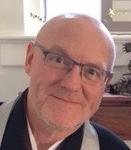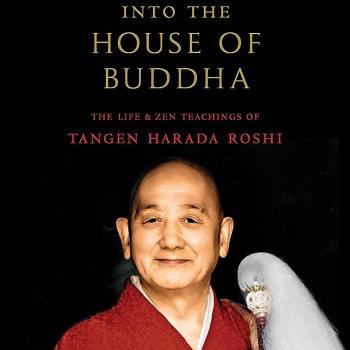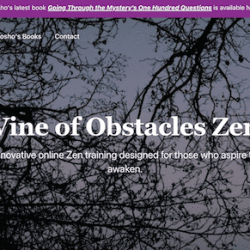 Hakuin (1686 – 1768), the great revitalizer of Rinzai Zen, had blistering criticisms of practitioners of silent-illumination meditation. Indeed, Seo and Addiss identify this as one of the main themes of Hakuin’s teaching, “A continued denunciation of those who contribute to the decline of Zen, particularly through the incorporation of Pure Land Buddhist practices and/or the sole use of ‘silent meditation’ (1).”
Hakuin (1686 – 1768), the great revitalizer of Rinzai Zen, had blistering criticisms of practitioners of silent-illumination meditation. Indeed, Seo and Addiss identify this as one of the main themes of Hakuin’s teaching, “A continued denunciation of those who contribute to the decline of Zen, particularly through the incorporation of Pure Land Buddhist practices and/or the sole use of ‘silent meditation’ (1).”
However, in The Complete Poison Blossoms in a Thicket of Thorn (CPB), much of the vitriol is directed at silent illumination and the Sōtō monks who practiced it, as well as those in the Rinzai school that had continued the “unborn” approach of Bankei (1622-1693), and not so much at the Pure Land school.
In this post, I’ll dig into the nature of Hakuin’s criticisms and invite the reader to consider whether and how these criticisms apply to our contemporary dharma scene. I plan to return to this latter theme in a future post. First, though, more than a few words about who it is that Hakuin is criticizing.
Disclaimer: we really don’t know much about either Sōtō or Rinzai Zen in the 1700s. Hakuin frequently reports observations like this: “These days in temples throughout the country people are immersing themselves in the dead, stagnant waters of quiescent silent illumination Zen.”
In digging around in the available histories of the period, especially Zen Buddhism a History: Japan, by Heinrich Dumoulin, I find no mention of this thriving community of Sōtō monks practicing silent illumination. What we do know about what was happening then in Sōtō school that has impacted our practice today was the work of Gesshū Sōko (1618–1696), Manzan Dōhaku (1636-1715), Menzan Zuihō (1683-1769), and Gentō Sokuchū (1729-1807), among others, who led a movement to return to the letter of Dōgen’s teaching.
During the previous century, the 1600s, a new influx of Ch’an teachers from China had come to Japan, and became known as the Obakū school, offering the combination of Ch’an and Pure Land popular on the mainland. Most well-known teachers in both the Sōtō and Rinzai schools through the 1600s and 1700s had some direct monastic training within this new school. And as you might expect, it worked for some and not for others, instigating strong reactions and reforms in both the Sōtō and Rinzai schools. The sorting out of Pure Land influences in the Sōtō and Rinzai schools during the 1700s, for example, may have been more a reaction to the Obakū school than to the native Pure Land schools of Japan.
Gentō Sokuchū, as the 50th abbot of Eiheiji, is renowned in Sōtō Zen lore for having set fire to the large mokugyo (fish drum) that was used for chanting, apparently because he also wanted to expunge Pure Land elements from Sōtō Zen. Gentō, by the way, was an older dharma brother of Ryōkan (1758–1831), the great poet monk. Gentō’s efforts to “purify” the Sōtō practice disturbed Ryōkan so much that he literally headed for the hills and lived out his life as a hermit poet (2).
Given that all these monks, including Ryōkan, were into the letter of Dōgen Zen, and that Dōgen in all his writing never mentioned “silent illumination,” it seems unlikely that these teachers or the monastics in their monasteries were framing their practice as “silent illumination.”
Since other sources do not confirm Hakuin’s reports about the prominence of the practice of silent illumination, I got to wondering if Hakuin was constructing a foil, a straw man, in order to contrast his vigorous style of kōan introspection and turning the wheel of the four great vows? After all, it would be consistent with elements of his robust, wholehearted, extroverted style to exaggerate just a tiny bit. If so, he may have been constructing a narrative that followed on the heels of Dahui Zonggao (1089–1163), who was widely regarded, like Hakuin became, of being responsible for reforming the kōan practice of his day, while also emphasizing the importance of kenshō.
On the other hand, Hakuin’s impression of thriving hordes of silent illuminators might come from Hakuin’s early pilgrimage years when he travelled widely, perhaps gaining first-hand knowledge of on-the-ground Sōtō Zen in the early 1700’s that wasn’t maintained in the available records. Which is right? This question, to my knowledge, cannot be answered at this time.
Hakuin does not appear to have been acquainted with the Sōtō monks mentioned above nor another who is well-known today, Tenkei Denson (1648-1735), an advocate for the use of kōan. Tenkei also published a controversial commentary on Dōgen’s Shōbōgenjō, and generally had a view of things much more like Hakuin than his Sōtō contemporaries and received plenty of blow-back for it.
It is also worth noting that not all of the experiences Hakuin reported with Sōtō Zen were negative. Hakuin tells (CPB #423) of spending a practice period at Sōtō temple, Inryō-ji, and having a wonderful experience. Hakuin had glowing words for the Inryō-ji Sōtō teacher, saying, “Daigan Rōshi was an excellent priest, a straight and unbowed branch of the Zen forest, a splendid panicle of rice from its Dharma fields.”
Hakuin was even invited to be the next abbot of Inryō-ji, one of the many indications in the works of Hakuin that the Sōtō and Rinzai schools were not as distinct in his day as they are today.
Finally, in CPB and in other works, Hakuin regularly reports meetings with Sōtō monks who came to Shōin-ji to have practice interviews with him. Based on all this, it seems to me that Hakuin’s criticisms of Sōtō practitioners were based primarily on principle rather than sectarian motivations.
What principles?
Hakuin’s blistering criticisms of silent illumination (Soto) Zen
Hakuin had five main criticisms of silent illumination that he repeated in various forms throughout his career:
-
- The zazen of silent illumination Zen is a passive pursuit of a state of perfect purity, and sometimes just a do-nothing practice of zoning out, sleeping, and generally wasting the resources of donors.
- Silent illumination Zen takes kensho as something that is inherent, too pure to experience, or already realized, and so denies the reality and significance of a personal experience of kensho.
- Because silent illumination Zen denies kensho, it has no inclination for post-satori development like Hakuin’s method for post-satori practice – digging into many koans and sutras.
- Silent illumination Zen takes the dharma as a belief system and so the power of such teachings as “formlessness” and “no mind” is lost in doctrinal dharma (as opposed to personally putting it to work).
- Silent illumination Zen denied karma and rebirth.
Rather than pedantically explain these one-by-one, I’m inclined to let Hakuin speak for himself. Here are a couple examples where he touches on most of the above themes:
“These days in temples throughout the country people are immersing themselves in the dead, stagnant waters of quiescent silent illumination Zen. Making no headway whatever, achieving nothing at all, they just dilly-dally their lives away in that state, half-alive, half-dead. They reject the essential matter of koan work, shoving it aside without a thought, having no more use for it than a merchant would for a mattock or plow. One of their teachers says things like this: ‘Don’t look at the koan stories; they are a muddy quagmire that will only suck your self-nature under. Don’t look at words or letters; that is a dense thicket filled with entangling vines that will strangle all the life from your Zen spirit. Your self-nature has no love for words and letters. It has no fondness for koans. It wants simply to retain an easy tranquility, a free and unrestricted state of mind. That is the true and authentic meaning of Zen’s direct pointing. The self-nature that is inborn in each and every person is originally perfectly clear, free, and unrestricted (3).'”
and
“There are priests today who pride themselves on teaching the doctrine of silent illumination, do-nothing Zen. They dispense with all acts that benefit either themselves or others. They preach the doctrine of no-mind while their minds are filled with thought, they seek formlessness while still clutching tightly to form. They are content when they have located a temple with comfortable quarters and plenty to eat, and there they sleep their lives vainly away in a state of ignorance (4).”
If you are a follower of Sōtō Zen, especially in a lineage that conflates silent illumination with shikantaza (aka, “just sitting”), Hakuin’s criticism might seem startling and even offensive to you. “Anyway,” you might say, “just because Hakuin was critical of some Sōtō Zen practice, doesn’t mean that his criticisms were valid or still are today.”
I agree. A question for Sōtō Zen practitioners in our times, though, is simple – are they?
(1) The Sound of One Hand: Painting and Calligraphy by Zen Master Hakuin, Audrey Yoshiko Seo and Stephen Addiss, pp. 8-9.
(2) See “Emerging from Nonduality: Kōan Practice in the Rinzai Tradition Since Hakuin,” by Michel Mohr, in The Kōan: Texts and Contexts in Zen Buddhism, p. 245.
(3) CPB, “189. Reply to Priest Rempō of Keirin-ji.”
(4) CPB, “429. Gudō’s Lingering Radiance.”
________________












